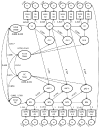Developmental relations between vocabulary knowledge and reading comprehension: a latent change score modeling study
- PMID: 25201552
- PMCID: PMC4331220
- DOI: 10.1111/cdev.12292
Developmental relations between vocabulary knowledge and reading comprehension: a latent change score modeling study
Abstract
The present study followed a sample of first-grade (N = 316, Mage = 7.05 at first test) through fourth-grade students to evaluate dynamic developmental relations between vocabulary knowledge and reading comprehension. Using latent change score modeling, competing models were fit to the repeated measurements of vocabulary knowledge and reading comprehension to test for the presence of leading and lagging influences. Univariate models indicated growth in vocabulary knowledge, and reading comprehension was determined by two parts: constant yearly change and change proportional to the previous level of the variable. Bivariate models indicated previous levels of vocabulary knowledge acted as leading indicators of reading comprehension growth, but the reverse relation was not found. Implications for theories of developmental relations between vocabulary and reading comprehension are discussed.
© 2014 The Authors. Child Development © 2014 Society for Research in Child Development, Inc.
Figures





Similar articles
-
Differential Co-Development of Vocabulary Knowledge and Reading Comprehension for Students with and without Learning Disabilities.J Educ Psychol. 2020 Apr;112(3):608-627. doi: 10.1037/edu0000382. Epub 2019 Jun 20. J Educ Psychol. 2020. PMID: 32189724 Free PMC article.
-
Conditional Longitudinal Relations of Elementary Literacy Skills to High School Reading Comprehension.J Learn Disabil. 2019 Jul/Aug;52(4):324-336. doi: 10.1177/0022219419851757. J Learn Disabil. 2019. PMID: 31204614
-
The simple view of reading redux: vocabulary knowledge and the independent components hypothesis.J Learn Disabil. 2012 Sep-Oct;45(5):453-66. doi: 10.1177/0022219411432685. Epub 2012 Jan 31. J Learn Disabil. 2012. PMID: 22293683
-
The interface between spoken and written language: developmental disorders.Philos Trans R Soc Lond B Biol Sci. 2013 Dec 9;369(1634):20120395. doi: 10.1098/rstb.2012.0395. Print 2014. Philos Trans R Soc Lond B Biol Sci. 2013. PMID: 24324239 Free PMC article. Review.
-
Contribution of Vocabulary Knowledge to Reading Comprehension Among Chinese Students: A Meta-Analysis.Front Psychol. 2020 Oct 2;11:525369. doi: 10.3389/fpsyg.2020.525369. eCollection 2020. Front Psychol. 2020. PMID: 33132948 Free PMC article.
Cited by
-
Study of a set of reading precursors among Chilean children with Down syndrome.Front Psychol. 2023 Feb 6;14:1090710. doi: 10.3389/fpsyg.2023.1090710. eCollection 2023. Front Psychol. 2023. PMID: 36814660 Free PMC article.
-
Examining the Relations of the Home Literacy Environments of Families of Low SES with Children's Early Literacy Skills.J Educ Stud Placed Risk. 2019;24(2):154-173. doi: 10.1080/10824669.2019.1602473. Epub 2019 Apr 16. J Educ Stud Placed Risk. 2019. PMID: 32346284 Free PMC article.
-
The Relationship Between Reading Strategy and Reading Comprehension: A Meta-Analysis.Front Psychol. 2021 Aug 4;12:635289. doi: 10.3389/fpsyg.2021.635289. eCollection 2021. Front Psychol. 2021. PMID: 34421702 Free PMC article. Review.
-
The Relations Between Children's Comprehension Monitoring and Their Reading Comprehension and Vocabulary Knowledge: An Eye-Movement Study.Read Writ. 2020 Mar;33(3):511-545. doi: 10.1007/s11145-019-09966-3. Epub 2019 Jul 20. Read Writ. 2020. PMID: 32189831 Free PMC article.
-
A Cross-Lagged Panel Analysis of Psychometric Intelligence and Achievement in Reading and Math.J Intell. 2017 Sep 1;5(3):31. doi: 10.3390/jintelligence5030031. J Intell. 2017. PMID: 31162422 Free PMC article.
References
-
- Abelson RP. A variance explanation paradox: When a little is a lot. Psychological Bulletin. 1985;97:129–133. doi: 10.1037/0033-2909.97.1.129. - DOI
-
- Anderson R, Freebody P. Vocabulary knowledge. In: Guthrie JT, editor. Comprehension and teaching: Research reviews. Newark, DE: International Reading Association; 1981. pp. 77–117.
-
- Beck I, McKeown M. Conditions of vocabulary acquisition. In: Barr R, Kamil ML, Mosenthal PB, Pearson PD, editors. Handbook of reading research. New York: Longman; 1991. pp. 789–814.
-
- Beck I, Perfetti C, McKeown M. Effects of long-term vocabulary instruction on lexical access and reading comprehension. Journal of Educational Psychology. 1982;74:506–521. doi: 10.1037/0022-0663.74.4.506. - DOI
-
- Cain K. Deriving word meanings from context: Does explanation facilitate contextual analysis? Journal of Research in Reading. 2007;30:347–359. doi: 10.1111/j.1467-9817.2007.00336.x. - DOI
Publication types
MeSH terms
Grants and funding
LinkOut - more resources
Full Text Sources
Other Literature Sources
Medical

